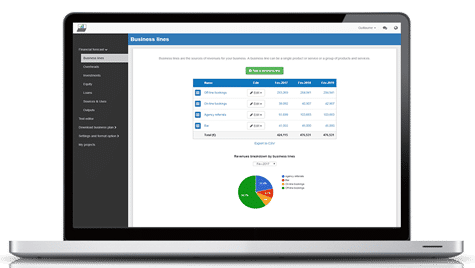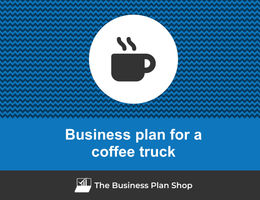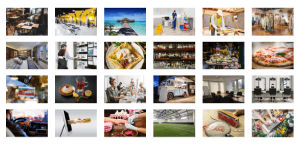How to create a financial forecast for a coffee truck?
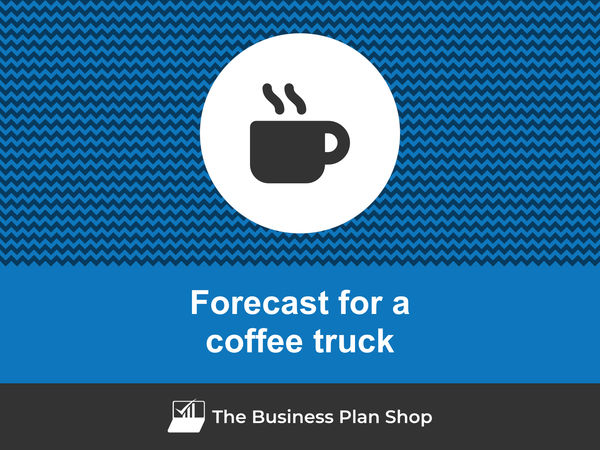
Creating a financial forecast for your coffee truck, and ensuring it stays up to date, is the only way to maintain visibility on future cash flows.
This might sound complex, but with the right guidance and tools, creating an accurate financial forecast for your coffee truck is not that hard.
In this guide, we'll cover everything from the main goal of a financial projection, the data you need as input, to the tables that compose it, and the tools that can help you build a forecast efficiently.
Without further ado, let us begin!
Why create and maintain a financial forecast for a coffee truck?
The financial projections for your coffee truck act as a financial blueprint to guide its growth with confidence and ensure its long-term financial viability.
To create them, you will need to look at your business in detail - from sales to operating costs and investments - to assess how much profit it can generate in the years to come and what will be the associated cash flows.
During challenging market conditions, maintaining an up-to-date financial forecast enables early detection of potential financial shortfalls, allowing for timely adjustments or securing financing before facing a cash crisis.
Your coffee truck's financial forecast will also prove invaluable when seeking financing. Banks and investors will undoubtedly request a thorough examination of your financial figures, making precision and presentation essential.
Need a solid financial forecast?
The Business Plan Shop does the maths for you. Simply enter your revenues, costs and investments. Click save and our online tool builds a three-way forecast for you instantly.
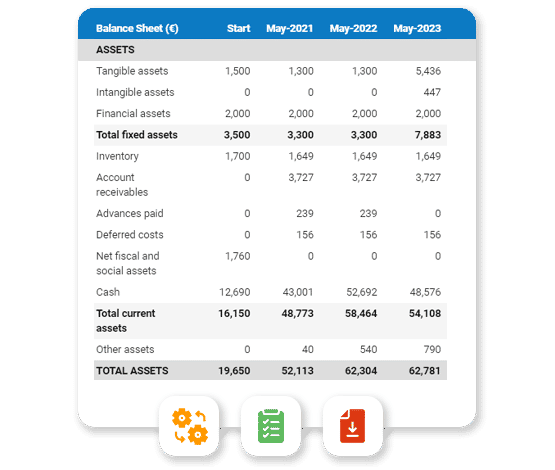
What information is used as input to build a coffee truck financial forecast?
A coffee truck's financial forecast needs to be built on the right foundation: your assumptions.
The data required to create your assumptions will depend on whether you are a new or existing coffee truck.
If you are creating (or updating) the forecast of an existing coffee truck, then your main inputs will be historical accounting data and operating metrics, and your team’s view on what to expect for the next three to five years.
If you are building financial projections for a new coffee truck startup, you will need to rely on market research to form your go-to-market strategy and derive your sales forecast.
For a new venture, you will also need an itemised list of resources needed for the coffee truck to operate, along with a list of equipment required to launch the venture (more on that below).
Now that you understand what is needed, let’s have a look at what elements will make up your coffee truck's financial forecast.
The sales forecast for a coffee truck
From experience, it usually makes sense to start your coffee truck's financial projection with the revenues forecast.
The inputs used to forecast your sales will include the historical trading data of your coffee truck (which can be used as a starting point for existing businesses) and the data collected in your market research (which both new ventures and existing businesses need to project their sales forward).
Your coffee truck's sales forecast can be broken down into two key estimates:
- The average price
- The number of monthly transactions
To assess these variables accurately, you will need to consider the following factors:
- Location: The location of your coffee truck can greatly impact your average price and number of monthly transactions. A prime location with heavy foot traffic can allow you to charge higher prices and attract more customers, while a less visible location may result in lower prices and fewer sales.
- Seasonal demand: The demand for coffee can vary greatly depending on the season. For example, during colder months, customers may be more likely to purchase hot coffee, while in warmer months, they may prefer iced coffee. This can affect your average price and number of monthly transactions.
- Menu offerings: The variety and quality of your menu offerings can impact the average price of your coffee and the number of monthly transactions. If you offer unique and high-quality items, you may be able to charge higher prices and attract more customers.
- Competition: The presence of other coffee trucks or coffee shops in the area can also affect your business's average price and number of monthly transactions. If there is a lot of competition, you may need to lower your prices to stay competitive, which can impact your profits.
- Events and festivals: Participating in events and festivals can greatly increase the number of monthly transactions for your coffee truck. These events attract a large number of people who may be potential customers, and it also allows you to charge higher prices for your products.
Once you have a sales forecast in place, the next step will be to work on your overhead budget. Let’s have a look at that now.
Need inspiration for your business plan?
The Business Plan Shop has dozens of business plan templates that you can use to get a clear idea of what a complete business plan looks like.
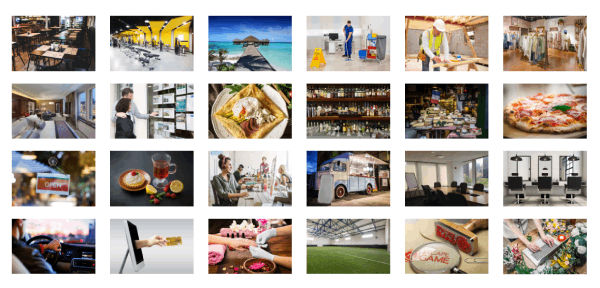
The operating expenses for a coffee truck
The next step is to estimate the costs you’ll have to incur to operate your coffee truck.
These will vary based on where your business is located, and its overall size (level of sales, personnel, etc.).
But your coffee truck's operating expenses should normally include the following items:
- Staff Costs: This includes wages, salaries, and benefits for your employees, such as baristas and food truck drivers.
- Accountancy Fees: You may need to hire an accountant to help with bookkeeping, tax preparation, and financial planning for your coffee truck.
- Insurance Costs: You'll need to purchase insurance to protect your coffee truck and its contents, as well as liability insurance for any potential accidents or injuries.
- Software Licences: If you use any software for inventory management, scheduling, or payment processing, you'll need to pay for the necessary licenses.
- Banking Fees: You'll likely have to pay fees for bank accounts, credit card processing, and other financial services for your coffee truck.
- Fuel and Maintenance: This includes the cost of gasoline or diesel for your truck, as well as regular maintenance and repairs to keep it running smoothly.
- Food and Beverage Supplies: You'll need to purchase coffee beans, syrups, milk, and other ingredients to make your drinks, as well as any food items you plan to sell.
- Packaging and Utensils: To serve your drinks and food, you'll need to buy cups, lids, straws, utensils, and other packaging materials.
- Rent or Lease: If you don't own your coffee truck, you'll need to pay rent or lease fees to use it.
- Permits and Licenses: You may need to obtain permits and licenses from the local government to operate your coffee truck.
- Marketing and Advertising: To attract customers, you'll need to spend money on marketing and advertising efforts, such as social media ads or flyers.
- Utilities: You'll need to pay for electricity, water, and other utilities to power your coffee truck and keep it clean.
- Vehicle Registration and Insurance: In addition to insurance, you'll need to pay for vehicle registration and any necessary inspections for your coffee truck.
- Commissary Fees: If you use a commissary kitchen to prep your food and drinks, you'll need to pay for the use of their facilities and equipment.
- Uniforms and Supplies: You may want to provide uniforms for your employees, as well as purchase cleaning supplies and other necessary items for your coffee truck.
This list is not exhaustive by any means, and will need to be tailored to your coffee truck's specific circumstances.
What investments are needed to start or grow a coffee truck?
Creating and expanding a coffee truck also requires investments which you need to factor into your financial forecast.
Capital expenditures and initial working capital items for a coffee truck could include elements such as:
- Truck: This is the most significant capital expenditure for your coffee truck. It includes the cost of purchasing or leasing the truck, as well as any necessary modifications or upgrades to make it suitable for your business. This could include adding a coffee machine, refrigeration units, and storage space.
- Equipment: In addition to the truck, you will need to purchase or lease various equipment to operate your coffee truck. This can include a coffee grinder, espresso machine, blender, and any other tools necessary for making and serving coffee and other beverages. Make sure to factor in the cost of maintenance and repairs for these items as well.
- POS System: A point of sale (POS) system is essential for processing and tracking sales on your coffee truck. This includes hardware such as a tablet or cash register, as well as software for inventory management and sales reporting. Invest in a reliable POS system that can handle the unique needs of a mobile business.
- Generator: Since your coffee truck will be operating on the go, you will need a reliable source of power. A generator is a necessary investment to keep your equipment running and your beverages hot and cold. Consider the size and type of generator that will best suit your needs and budget.
- Branding and Design: While not a traditional capital expenditure, investing in branding and design is crucial for the success of your coffee truck. This includes creating a logo, designing menus and signage, and branding your truck's exterior. These elements will help attract customers and make your business stand out in a crowded market.
Again, this list is not exhaustive and will need to be adjusted according to the circumstances of your coffee truck.
Need a convincing business plan?
The Business Plan Shop makes it easy to create a financial forecast to assess the potential profitability of your projects, and write a business plan that’ll wow investors.
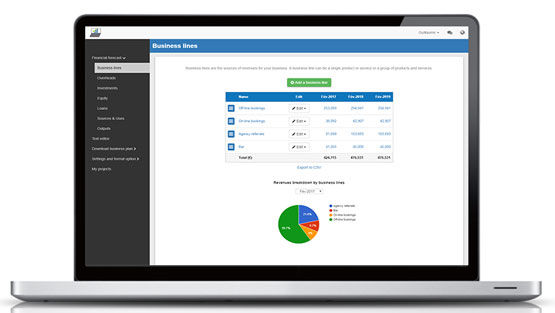
The financing plan of your coffee truck
The next step in the creation of your financial forecast for your coffee truck is to think about how you might finance your business.
You will have to assess how much capital will come from shareholders (equity) and how much can be secured through banks.
Bank loans will have to be modelled so that you can separate the interest expenses from the repayments of principal, and include all this data in your forecast.
Issuing share capital and obtaining a bank loan are two of the most common ways that entrepreneurs finance their businesses.
What tables compose the financial plan for a coffee truck?
Now let's have a look at the main output tables of your coffee truck's financial forecast.
The profit & loss forecast
The forecasted profit & loss statement will enable you to visualise your coffee truck's expected growth and profitability over the next three to five years.
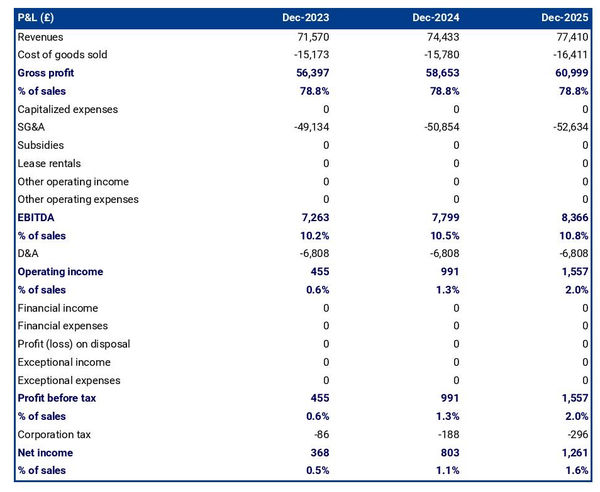
A financially viable P&L statement for a coffee truck should normally show:
- Sales growing above inflation
- Stable or expanding (ideally) profit margins
- A net profit
This will of course depend on the stage of your business: a new venture might be loss-making until it reaches its breakeven point in year 2 or 3, for example.
The projected balance sheet
Your coffee truck's forecasted balance sheet enables you to assess your financial structure and working capital requirements.
It is composed of three types of elements: assets, liabilities and equity:
- Assets: represent what the business owns and uses to produce cash flows. It includes resources such as cash, equipment, and accounts receivable (money owed by clients).
- Liabilities: represent funds advanced to the business by lenders and other creditors. It includes items such as accounts payable (money owed to suppliers), taxes due and loans.
- Equity: is the combination of what has been invested by the business owners and the cumulative profits and losses generated by the business to date (which are called retained earnings). Equity is a proxy for the value of the owner's stake in the business.

The cash flow forecast
Your coffee truck's cash flow forecast shows how much cash your business is expected to consume or generate in the years to come.
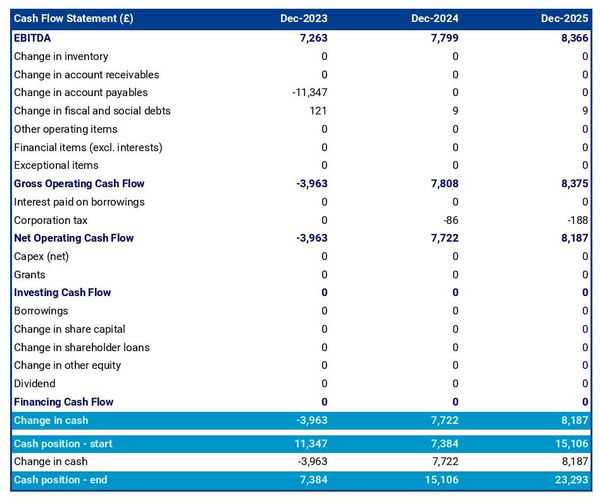
It is best practice to organise the cash flow forecast by nature to better explain where cash is used or generated by the coffee truck:
- Operating cash flow: shows how much cash is generated by the operating activities
- Investing cash flow: shows how much will be invested in capital expenditure to maintain or expand the business
- Financing cash flow: shows if the business is raising new capital or repaying financiers (debt repayment, dividends)
Keeping an eye on (and regularly updating) your coffee truck's cash flow forecast is key to ensuring that your business has sufficient liquidity to operate normally and to detect financing requirements as early as possible.
If you are trying to raise capital, you will normally be asked to provide a monthly cash flow forecast in your coffee truck's financial plan - so that banks or investors can assess seasonal variation and ensure your business is appropriately capitalised.
Need a solid financial forecast?
The Business Plan Shop does the maths for you. Simply enter your revenues, costs and investments. Click save and our online tool builds a three-way forecast for you instantly.

Which tool should you use to create your coffee truck's financial forecast?
Creating your coffee truck's financial forecast may sound fairly daunting, but the good news is that there are several ways to go about it.
Using online financial projection software to build your coffee truck's forecast
The modern and easiest way to build a forecast is to use professional financial projection software such as the one we offer at The Business Plan Shop.
There are several advantages to using specialised software:
- You can easily create your financial forecast by letting the software take care of the financial calculations for you without errors
- You have access to complete financial forecast templates
- You get a complete financial forecast ready to be sent to your bank or investors
- You can easily track your actual financial performance against your financial forecast, and recalibrate your forecast as the year goes by
- You can create scenarios to stress test your forecast's main assumptions
- You can easily update your forecast as time goes by to maintain visibility on future cash flows
- You have a friendly support team on standby to assist you when you are stuck
- It’s cost-efficient and much cheaper than using an accountant or consultant (see below)
If you are interested in this type of solution, you can try our forecasting software for free by signing up here.
Calling in a financial consultant or chartered accountant
Outsourcing the creation of your coffee truck financial forecast is another possible solution.
This will cost more than using software as you can expect as your price will have to cover the accountant’s time, software cost, and profit margin.
Price can vary greatly based on the complexity of your business. For a small business, from experience, a simple three-year financial forecast (including a balance sheet, income statement, and cash flow statement) will start at around £700 or $1,000.
Bear in mind that this is for forecasts produced at a single point in time, updating or tracking your forecast against actuals will cost extra.
If you decide to outsource your forecasting:
- Make sure the professional has direct experience in your industry and is able to challenge your assumptions constructively.
- Steer away from consultants using sectorial ratios to build their client’s financial forecasts (these projections are worthless for a small business).
Why not use a spreadsheet such as Excel or Google Sheets to build your coffee truck's financial forecast?
Creating an accurate and error-free coffee truck financial forecast with a spreadsheet is very technical and requires a deep knowledge of accounting and an understanding of financial modelling.
Very few business owners are financially savvy enough to be able to build a forecast themselves on Excel without making mistakes.
Lenders and investors know this, which is why forecasts created on Excel by the business owner are often frowned upon.
Having numbers one can trust is key when it comes to financial forecasting and to that end using software is much safer.
Using financial forecasting software is also faster than using a spreadsheet, and, with the rise of artificial intelligence, software is also becoming smarter at helping us analyse the numbers to make smarter decisions.
Finally, like everything with spreadsheets, tracking actuals vs. forecasts and keeping your projections up to date as the year progresses is manual, tedious, and error-prone. Whereas financial projection software like The Business Plan Shop is built for this.
Need a convincing business plan?
The Business Plan Shop makes it easy to create a financial forecast to assess the potential profitability of your projects, and write a business plan that’ll wow investors.

Use our financial forecast templates for inspiration
The Business Plan Shop has dozens of financial forecast examples available.
Our templates contain both a financial forecast and a written business plan which presents, in detail, the company, the team, the strategy, and the medium-term objectives.
Our templates are a great source of inspiration, whether you just want to see what a complete business plan looks like, or are looking for concrete examples of how you should model financial elements in your own forecast.
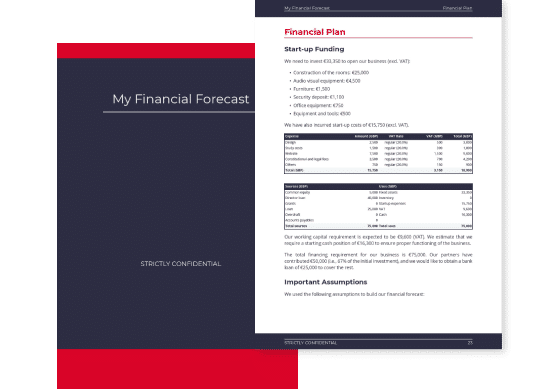
Takeaways
- A financial forecast shows expected growth, profitability, and cash generation metrics for your coffee truck.
- Tracking actuals vs. forecast and having an up-to-date financial forecast is key to maintaining visibility on your future cash flows.
- Using financial forecasting software is the modern way of creating and maintaining financial projections.
We hope that this guide helped you gain a clearer perspective on the steps needed to create the financial forecast for a coffee truck. Don't hesitate to contact us if you have any questions!
Need inspiration for your business plan?
The Business Plan Shop has dozens of business plan templates that you can use to get a clear idea of what a complete business plan looks like.

Also on The Business Plan Shop
Know someone who runs a coffee truck? Share our business guide with them!

